
Minangkabau people, also known as Minang, are an Austronesian ethnic group native to the Minangkabau Highlands of West Sumatra, Indonesia. The Minangkabau's West Sumatera homelands was the seat of the Pagaruyung Kingdom, believed by early historians to have been the cradle of the Malay race, and the location of the Padri War.

West Sumatra is a province of Indonesia. It is on the west coast of the island of Sumatra and includes the Mentawai Islands off that coast. West Sumatra borders the Indian Ocean to the west, as well as the provinces of North Sumatra to the north, Riau to the northeast, Jambi to the southeast, and Bengkulu to the south. The province has an area of 42,119.54 km2 (16,262.45 sq mi), or about the same size as Switzerland, with a population of 5,534,472 at the 2020 census. The official estimate at mid 2023 was 5,757,210. The province is subdivided into twelve regencies and seven cities. It has relatively more cities than other provinces outside Java, although several of them are relatively low in population compared with cities elsewhere in Indonesia. Padang is the province's capital and largest city.
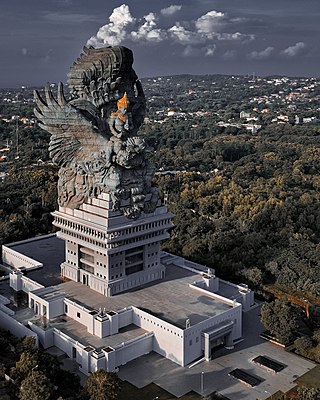
The culture of Indonesia has been shaped by the interplay of indigenous customs and diverse foreign influences. With over 1,300 distinct ethnic groups, including significant Austronesian and Melanesian cultures, contributing to its rich traditions, languages, and customs, Indonesia is a melting pot of diversity. Positioned along ancient trade routes between the Far East, South Asia, and the Middle East, the country has absorbed cultural practices influenced by Hinduism, Buddhism, Confucianism, Islam, and Christianity. These influences have created a complex cultural tapestry that often differs from the original indigenous cultures.
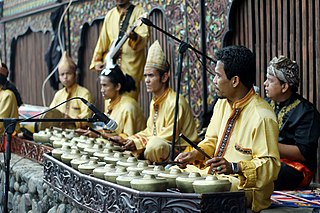
Talempong is a traditional music of the Minangkabau people of Western Sumatra, Indonesia. The talempong produce a static texture consisting of interlocking rhythms.
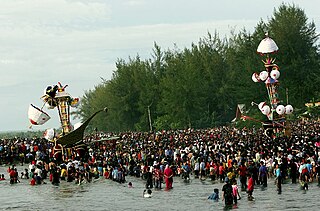
A Tabuik is the local manifestation of Remembrance of Muharram, in particular Shiite Ashura, among the Minangkabau people in the coastal regions of West Sumatra, Indonesia, particularly in the city of Pariaman.

The Overseas Minangkabau is a demographic group of Minangkabau people of Minangkabau Highlands origin in Central Sumatra, Indonesia who have settled in other parts of the world. Over half of the Minangkabau people can be considered overseas Minangkabaus. They make up the majority of the population of Negeri Sembilan and Pekanbaru. They also form a significant minority in the populations of Jakarta, Bandung, Medan, Batam, Surabaya and Palembang in Indonesia as well as Kuala Lumpur, Malacca, Penang, Singapore and Brunei Darussalam in the rest of the Malay world. Minangkabaus have also emigrated as skilled professionals and merchants to the Netherlands, United States, Saudi Arabia and Australia. The matrilineal culture and economic conditions in West Sumatra have made the Minangkabau people one of the most mobile ethnic group in Maritime Southeast Asia.

A surau is an Islamic assembly building in some regions of Sumatra and the Malay Peninsula used for worship and religious instruction. Generally smaller physical structures, its ritual functions are similar to those of a mosque, allow men and women, and are used more for religious instruction and festive prayers. They depend more on grassroots support and funding. They can be compared to the Arab zawiya. In Minangkabau society, they continued pre-Islamic traditions of a men's house, and are built on high posts.

Piring dance is a traditional Minangkabau plate dance originated and performed in West Sumatra, Indonesia. It is also performed in Negeri Sembilan, Malaysia. The dance might be performed by a group of women, men, or couples; each of whom holds a plate in each hand, and vigorously rotates or half rotates them in various formations and fast movements.
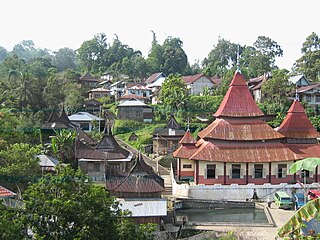
A nagari is a semi-autonomous Minangkabau people regional administrative unit in West Sumatra, Indonesia.

Islam is the most common religion in the Indonesian province of West Sumatra, embraced by 97.42% of the population. The Muslim population increases to 99.6% if it excludes the Mentawai Islands, where the majority of the non-Muslim (Protestant) West Sumatrans reside. Islam in West Sumatra is predominantly Sunni, though there is a small Shia Islamic pocket within the coastal city of Pariaman. The Minangkabau people, indigenous to West Sumatra, comprise 88% of the West Sumatran population today and have historically played an important role within Indonesia's Muslim community. Up until today, the region is considered one of the strongholds of Islam in Indonesia.
Tuanku Nan Tuo (1723–1830) or Tuan Ku Nan Tua was one of the leading Minangkabau ulamas. He was known as a wasatiyyah (moderate) cleric, who took syncretic approaches in the religious outlook, and was a Sufi and aspired for reformation and purification of Islam in the Agam region of West Sumatra at the same time. He also played a crucial role in the birth of Minangkabau Islamic reformers known as padri. Tuo however, disagreed with the more radically puritanical views espoused by padris including Tuanku Nan Renceh and Tuanku Imam Bonjol.
Ismail al-Khalidi al-Minangkabawi was an Islamic scholar who belonged to the Khalidiyya branch of the Naqshbandi tariqa in the 18th to 19th century. He hailed from today's Tanah Datar Regency, West Sumatra. He is regarded as the pioneer of the tariqa in Minangkabau region, as well as the whole Indonesian archipelago. He was also known as a scholar of Islamic jurisprudence, kalam theology and tasawwuf.
Burhanuddin Ulakan Pariaman, also known as Sheikh Burhanuddin Ulakan, was an Islamic cleric (ulama) from the Minangkabau region. He is regarded as the pioneer of Islamic propagators in West Sumatra. He is also known as a commanding figure of the Islamic movements against the Dutch colonization. Regarding his Islamic belief, he was a Sufi murshid belonging to the Shattari tariqa based in Minangkabau region.
Sumatera Thawalib was one of the earliest Islamic mass organizations in Indonesia, based in West Sumatra. Sumatera Thawalib represented the modernist school of Islam in Indonesia, an Islamic reform with heavy emphasis on the Qur'an, hadith, a modern scientific education, and abolishing of non-orthodoxy. Islamic Modernism was promoted by Muhammad Abduh. The term Sumatera Thawalib literally means "Students of Sumatra", and it was founded on January 15, 1919 as a result of meeting between the Muslim students of Padang Panjang, Parabek and Padang Japang. The aim of the organization was deepening of Islamic knowledge among the Muslim students. The organization had contributed substantially to the development of Islam in West Sumatra in the early 20th century.

Pasambahan dance is a Minangkabau traditional dance that has developed in various regions in the province of West Sumatra, Indonesia. Pasambahan dance is usually performed as a ceremonial welcoming dance to honor the guests and elders to a traditional ceremony. However, in nowadays, this dance is performed not only in ceremonial welcoming events, but also as performance art at public.
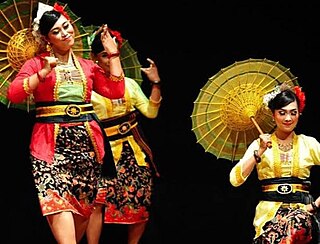
Payung dance is a folk dance-drama tradition of the Minangkabau-Malay ethnic group in Sumatra, Indonesia. This dance is a Minangkabau version of other Malay dances from Sumatra. Folk theatre such as toneel and sandiwara often incorporates payung dance as part of the show. The payung (umbrella) is the main prop used in this dance, and the dance itself, which is usually performed by three or four dancers, symbolizes affection and the relationship of young people. The dance originates from Western Sumatra, Indonesia.

Minangkabau culture is the culture of the Minangkabau ethnic group in Indonesia, part of the Indonesian culture. This culture is one of the two major cultures in the Indonesian archipelago which is very prominent and influential.

Music of Minang is a traditional and living genre of Indonesian music that grows and develops in the Minangkabau culture area. Music whose origins are related to Malay Music is generally played by musical instruments such as Talempong, Saluang, Minang rebab, Serunai, Tmbourine, Aguang, Gandang, and Violin. Minang music is also played to accompany various dances such as the Pasambahan dance and the Piring dance.

Marawa is a tricolour flag that consists of three vertical charts that feature the colours of the Minangkabau culture: black, red, and gold. It is not known for sure when this flag was first used, but it was officially adopted as the flag of the Pagaruyung Kingdom since its founding in 1347. This flag was also adopted by other kingdoms of the Minangkabau rantau such as the Inderapura Kingdom. A derivative of the flag is also currently used by Negeri Sembilan, a state in Malaysia with historical and cultural connections with the kingdom.





















